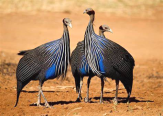题目内容
【题目】听下面一段较长对话,回答以下小题。
【1】What time was the plane originally scheduled to leave?
A.At 3:00.B.At 4:00.C.At 5:00.
【2】Why is the woman worried?
A.The weather is bad.
B.The report is not finished.
C.An appointment will be delayed.
【答案】
【1】A
【2】C
【解析】
【原文】
此题为听力题,解析略。

练习册系列答案
相关题目
